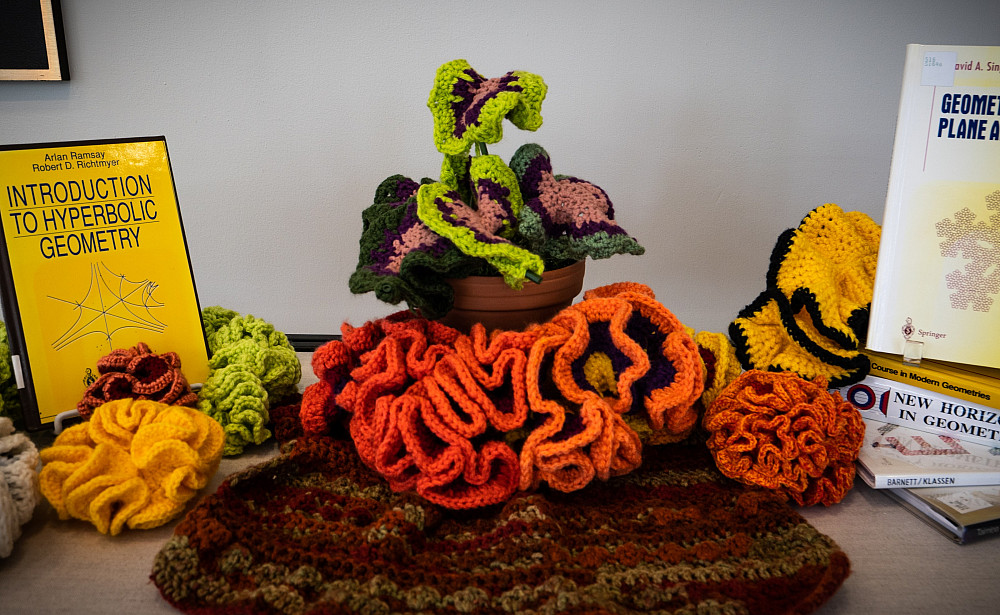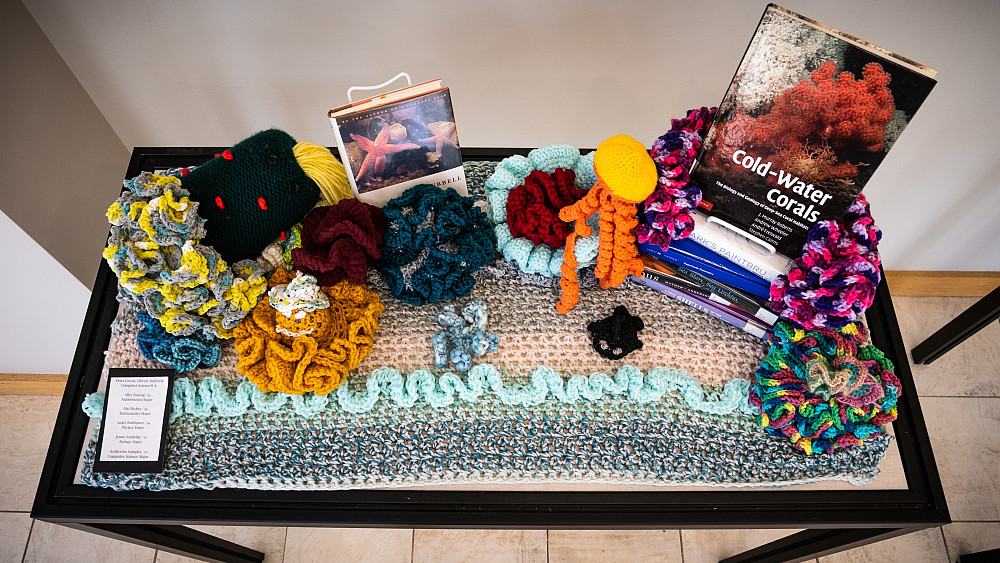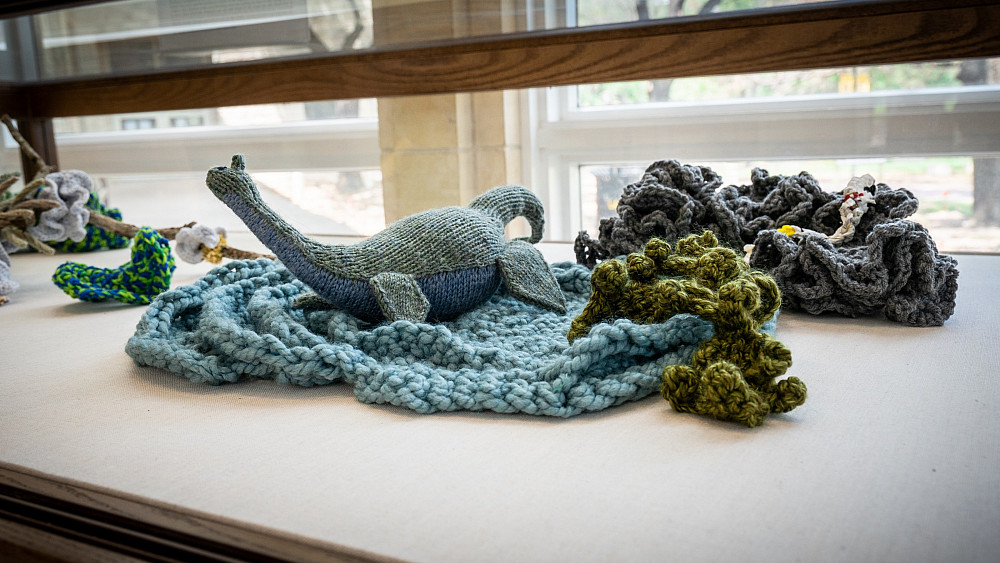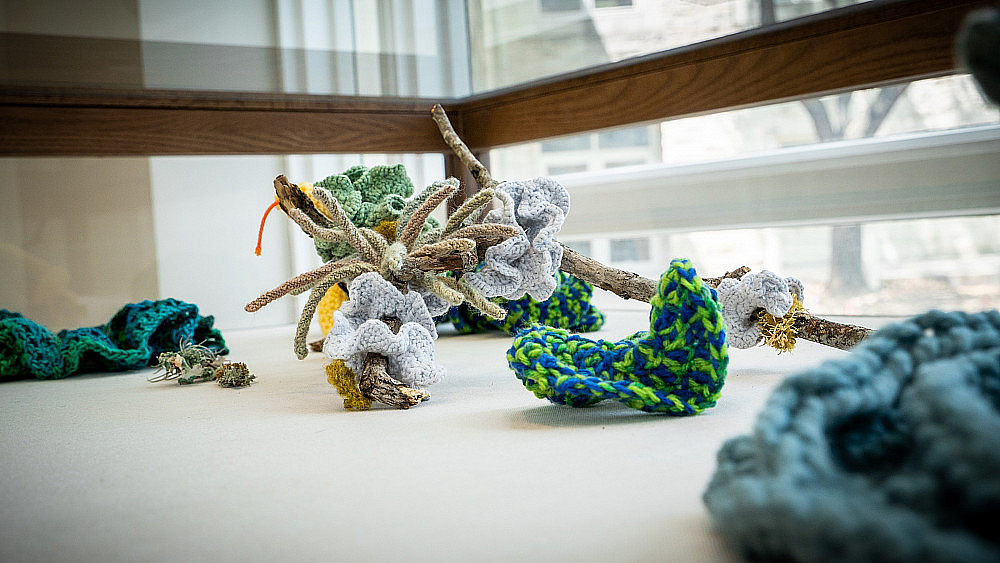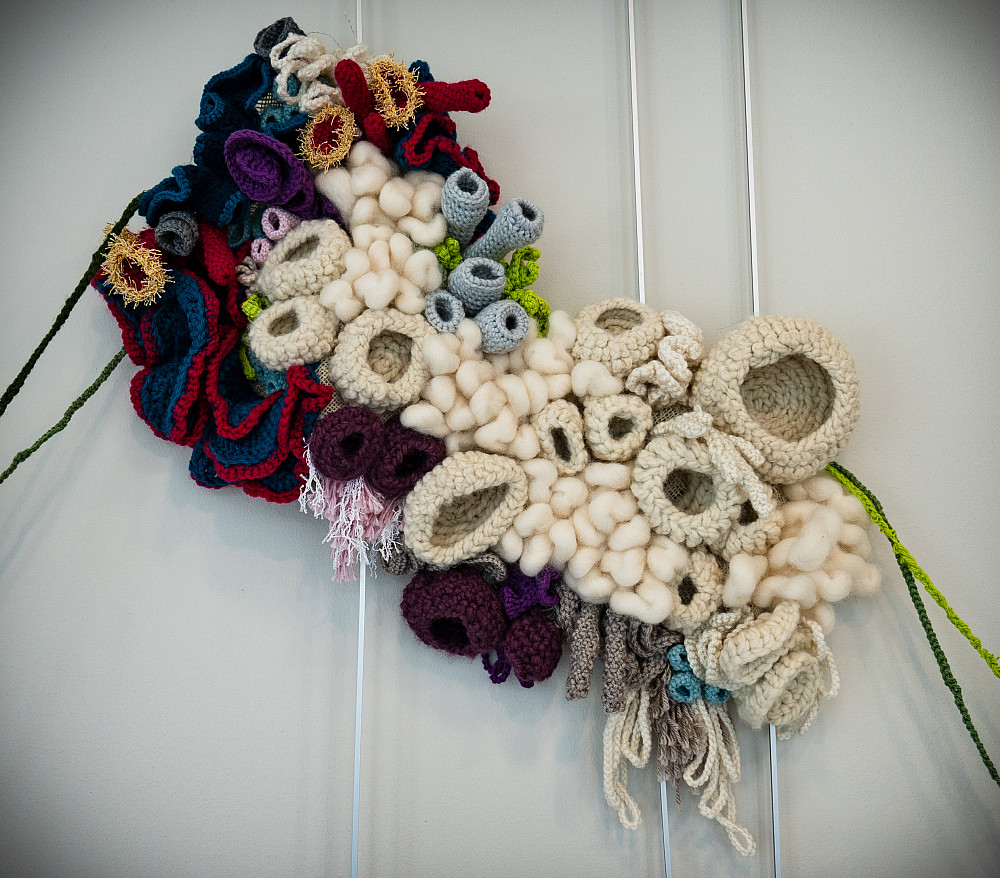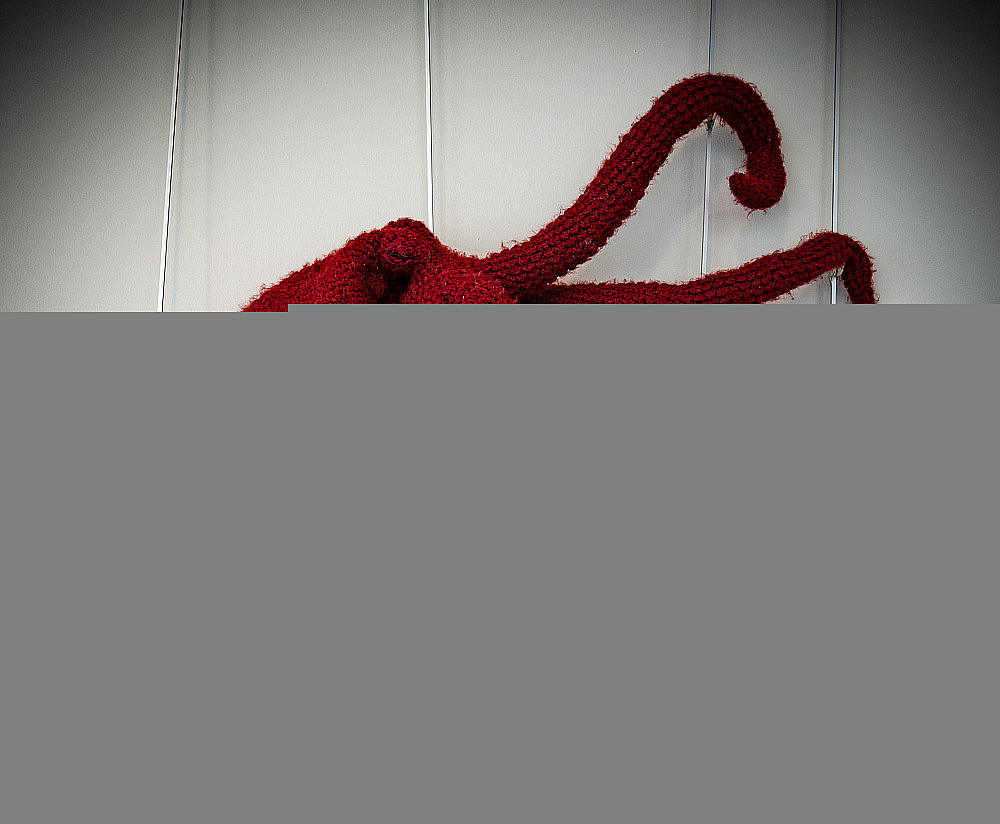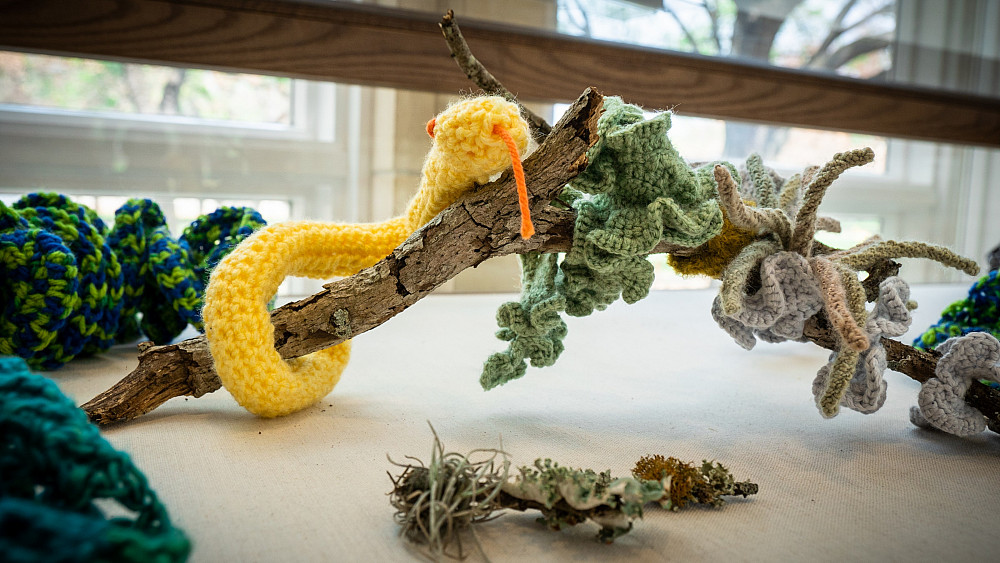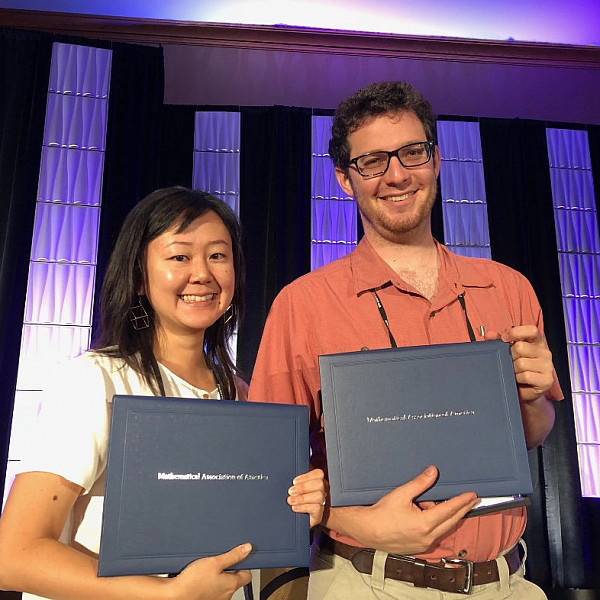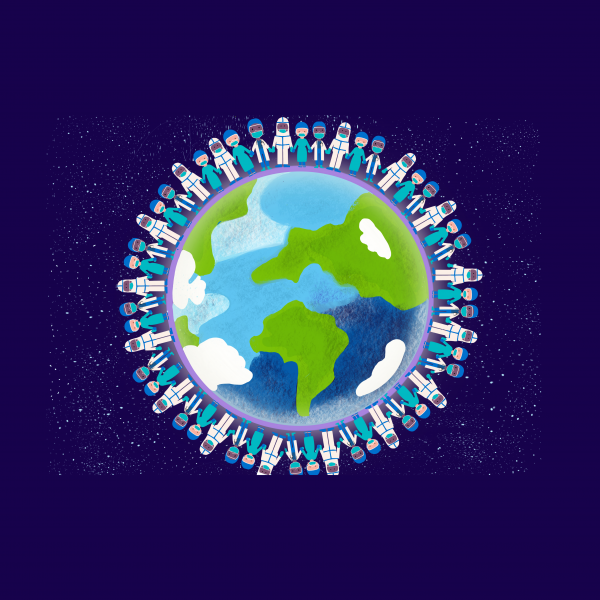News
A Close-Knit Community
April 29, 2021
April 29, 2021
In the sunny, glass-enclosed vestibule of the Smith Library, Southwestern community members might notice a sizable maroon octopus, lengthy vines, and a vibrant array of corals and other crocheted creatures on display. These colorful art pieces are the work of Professor of Mathematics and Lord Chair in Mathematics and Computer Science Fumiko Futamura, Infodesk Assistant Dena Garcia, and a talented group of science, math, computer science, physics, and biology majors. The objects are intended to mimic the undulating forms found in nature, such as the ruffled oral arms of a jellyfish or the sinuous body of a snake. But the Weaving Together Geometry and Biology: Hyperbolic Planes in the Natural World exhibit, which is on view until the end of the semester, is also a testament to values Southwestern holds dear: integrating seemingly unrelated fields, such as art with science, as well as building a supportive and tight-knit community among students, faculty, and staff.
Hyperbolic crochet is no exaggeration
The exhibit and the crocheting group who created it are the brainchild of Futamura, a mathematics scholar who is also a gifted artist working in various media, including paint, pen and ink, and charcoal. She began crocheting in 2009 after attending a talk at SU by Margaret Wertheim, an artist and science writer who cofounded a nonprofit that promotes the poetic and aesthetic dimensions of science, engineering, and mathematics. Futamura was inspired to learn how to crochet, and specifically to crochet hyperbolic forms (and if you’re rusty on your math, hyperbolic has nothing to do with hyperbole; imagine the flared and frilly shapes of calla lilies, kelp, sea slugs, or lettuce, and you’ll have a good reference point for hyperbolic structures in nature). So during a visit to her grandmother in Japan that summer, she learned the basics, and before long, she was creating complex creatures in yarn, including the gorgeous cephalopod currently on display in the Weaving Together exhibit. “That was one of the first things I made without a pattern,” she recalls. “Just for the head, you have to add stitches here or tighten it up to get that shape. There’s so much math involved in creating a perfect sphere versus the bulbous head of an octopus. That was really fun to feel through and make.”
Several years later, in the spring of 2018, the now-expert crocheter delivered lectures at SU about hyperbolic geometry while collaborating with a group of students and faculty to create a hyperbolic crochet coral reef for a Hot Science–Cool Talks event at the University of Texas at Austin. That project elicited great excitement from the students and resulted in a well-received exhibit in the SU library. So this past fall, while teaching Calculus I and with the first-year program Embracing Quantitative Understanding and the Inquiry Process (EQUIP), Futamura realized that assembling a similar group of Southwestern community members, this time virtually, to crochet a new exhibit of hyperbolic geometry would help people connect and create during a time of social distancing.
“I thought maybe if I could start a fun project that would culminate in something beautiful during a really difficult time, that would be really cool,” she says.
Connecting during COVID
Futumura got the word out about the project to her classes, and her students encouraged their friends to join, too. Math major Alley Koenig ’24, who was taking the professor’s calculus course at the time, was quick to join the group. “Dr. F. talked about it,” she recalls, “and I was like, ‘You crochet and you do math?!’” Originally a knitter at the age of 10 who switched to crochet in seventh grade, Koenig can spend hours at a time making funky patchwork sweaters and blankets while chatting with others or listening to audiobooks, so she jumped at the chance to socialize online with her professor and fellow crafters.
Like many people during the pandemic, physics major and EQUIP student Angel Rodriguez ’24 took up crocheting in April 2019 as a way to have something to do during the COVID-19 quarantines. He borrowed his sister’s yarn and crochet hooks and sought out tutorials online. When he later heard about the virtual meetups hosted by Futamura, he was on board, too. “It was fun to meet new people who shared the same interests I did,” he shares. “As the pandemic continues, I really wanted to make sure I was getting as much social interaction as possible, and the crochet club was a fun way to do so.”
Crochet veteran Katie Samples ’22 says that the group was important to her, too, since she wasn’t on campus. “This semester, I was remote, so the only socializing I did was in club meetings,” she shares.
More than 20 students attended the first meetings, with 10 or so students continuing to engage regularly in the weekly video chats during the course of the year. Because the group has always been open to new and long-time crocheters alike, some meetings focused on teaching or trading techniques. Early on, for example, Futamura shared some slides about hyperbolic surfaces and how to crochet them. Throughout the year, she and the more advanced students enjoyed tutoring newcomers, demonstrating how to create foundational slip knots, chains, slip stitches, and crochet stitches.
At many of the gatherings, the participants just crocheted while talking about whatever came to mind. “The meetings were a nice way to unwind from the day,” says Garcia, who works at the Smith Library. She developed her craft as a child, and while making granny squares for the blankets her grandmother would create, Garcia learned a lesson similarly demonstrated by the Southwestern crochet group: the importance of being part of something. “Everyone was slowing down, concentrating on their yarn project, and chatting and laughing, taking turns telling stories about themselves,” she says of the SU crocheters. “I love getting together this way, having a project on your lap but having time to totally listen to each other.”
Rodriguez agrees. “I enjoyed the fact that we are able to talk about literally anything,” he says. “It’s a really safe space where you can share your opinions or just talk about things you like or dislike.”
“It’s a really safe space where you can share your opinions or just talk about things you like or dislike.”
Having learned crochet from her grandmother at the age of seven or eight, Mel Richey ’24 was excited to have an opportunity to continue her craft at Southwestern. The Miami native echoes that the meetups became a welcome place “to relax, and it was a nice little escape from homework and other stuff.” She was grateful for the casual tone of the group, which she says “wasn’t like academic clubs because there were no rules to follow.” But as a math major, getting acquainted with a professor in her department she had not yet taken courses with was another benefit. “It led me to take a class with [Futamura] this semester,” Richey says. “Because of the club, it’s made me a lot more confident to talk to her. I’m a lot more comfortable reaching out to her and asking questions rather than shying away and trying to figure it out on my own.”
Crochet as a mental balm
Crocheting lessons and lively conversation were not the only items on the agenda. Still other weekly gatherings provided a quiet refuge among friends instead. Koenig recounts that at one meetup late in the year, when everyone was tired from a stressful week of school—not to mention a year of history-making national and global events—the group worked silently while watching The Little Prince together and occasionally contributing to a group chat.
Rodriguez adds that he appreciates that the group is such a no-stress, nonobligatory environment. “It doesn’t feel mandatory,” he explains, “so when you miss a meeting, it isn’t like, ‘Where were you?’ and more of a ‘We missed you!’ kind of feeling.”
For Futamura, one of the most rewarding outcomes of the group has been something akin to art therapy. “That’s one of the reasons crochet is a good option right now: it’s that meditative quality,” she explains. “You have to concentrate just hard enough, so you’re taking your mind off things like COVID. And then you’ve created this warm, squishy, beautiful thing. It’s so satisfying, especially when everything is so digital, because it’s something tangible that you’ve made with your hands.”
The ubiquitous beauty of mathematics
In addition to enjoying the community and calming effects of crocheting together virtually, the group set their sights on creating objects that would eventually be featured in an on-campus exhibit highlighting the beauty of hyperbolic geometry. But Futamura did not want the students to limit themselves. “I told them to make
whatever they wanted,” she says, “and they did.” Although they had complete artistic license, the students wanted at least some common thread among their creations, so the crocheters mimicked organisms found in nature, such as corals, vines, lichen on branches, a jellyfish, air plants, and a sea cucumber (“sea cucumbers have this amazing ability to spit out their intestines when they feel threatened, and I thought it would be pretty cool and a little funny to have one made out of yarn do it, too,” Rodriguez says). Emily Burns ’22, a computational math major from Alaska, even went the cryptozoological route with her contribution, creating a Loch Ness Monster.
“They were so creative,” Futamura says proudly. “I just love the creativity of all our students.”
The objects on display are certainly eye-catching, and to the uninitiated, they appear intimidatingly complicated. However, Koenig insists, “Hyperbolic structures are a really great way to get people into crochet because they’re really easy to do.” That’s because they don’t require straight lines of stitches; unlike creating, say, a sweater or an intricately patterned scarf or blanket, hyperbolic structures are intended to be crinkly and wavy and are therefore more forgiving to crochet. And although some crochet newbies never really moved beyond the basics this past year, their contributions—simple but delicately elegant vines—were encouraged and included as part of the library exhibit.
Beyond appreciating the aesthetics of hyperbolic geometry, the crocheters quickly discovered that such structures can be found everywhere, from the oceans and the leaves on trees to the produce section of grocery stores. “That’s what I want my students to be able to do with mathematics,” Futamura says excitedly. “People think math is so boring—just algebraic calculations—but math is beautiful, and it’s all around you. I want my students to recognize it and appreciate it.”
The 7Cs
Given the success of the informal crochet group at Southwestern (“everybody’s awesome in crochet club!” exclaims Koenig), its members decided to apply for status as a campus organization this spring. Of course, as can often happen in university settings, simply agreeing on a name for the new organization required multiple meetings—and generated a lot of laughter. Yarn jockeys are familiar with the sometimes funny, punny names of the stores where they purchase their supplies: the Naked Sheep, Woolmart, Pins and Needles, a Good Yarn. So the Southwestern hook-and-needle crowd initially tossed around similarly humorous monikers, such as Stitch and Bitch or, with the school’s pirate mascot in mind, the Hookup. But the group eventually settled on the 7Cs Crochet Club, with the 7Cs standing for crochet (obviously), community (same), creating (ditto), charity (because several members would like to work on projects such as crocheting and donating blankets to homeless shelters or dog toys and collars to rescue organizations), climate change (an issue close to the hearts of many members), and cosine (giving props to Futamura as leader and the group’s mathematically inspired exhibit and future projects).
Garcia says that how the 7Cs will meet in the fall depends on how the pandemic shapes campus life. It “may be outside or spaced,” she remarks, “but face-to-face would be my hope.” Koenig, who will be copresident of the organization, foresees regular meetings in the math lounge of the Fondren–Jones Science Center, with pizza parties and maybe even a fashion show. Futamura looks forward to annual exhibits and says that the students have discussed showcasing their work on an Instagram page as well. Richey would love for the group to focus on “contributing to the community.”
Whatever events the 7Cs Crochet Club ends up coordinating, its very existence and the Weaving Together exhibit have already demonstrated, as computer science major Samples says, “the connection of art and math that we were making.” Futamura agrees, adding that the club represents connecting not just subject areas but also people. “I think the reason students come to Southwestern is it’s a small school, so you get to know your professors, and you get to know other students more easily because you have these small classes,” she remarks. “That’s why I came here to SU: to get to know students better and to do more of this interdisciplinary work with students.”
“I think the Southwestern Experience is about making sure we use our time wisely and pursue things and experiences that interest us and help us grow.”
For Rodriguez, the club is not unlike the automated crochet machine that he recently designed and presented as his King Creativity Project at the annual Research and Creative Works Symposium because both represent the importance of doing what makes you happy and taking advantage of what’s available. “At Southwestern, there are opportunities to do a lot of things all over the place, but if you’re afraid to put yourself out there or even try, than you could be missing out on an amazing experience,” he shares. “I thought my King Creativity Project would have never been chosen, but I still applied anyway and got the chance to make something cool. I was also nervous to attend the crochet club, but now we’re a close-knit community (pun intended). I think the Southwestern Experience is about making sure we use our time wisely and pursue things and experiences that interest us and help us grow.”
Like a crocheter might stitch together the squares of a blanket, Weaving Together integrated different pieces of art into a single exhibit, and the 7Cs reflects a new group formed from the bonds between its members—a microcosm of the larger university. “SU is a community that is interested in finding what lies in between, in the spaces of disparate things, like finding out how hyperbolic geometry and crochet intersect,” says Garcia. “It’s a caring environment—both SU as a whole and this group. Coming together to crochet in the evenings was a real boost to my spirit during the pandemic. Seeing the individual pieces come together, looking even better together—that says it all right there!”
For more information on how to join the 7Cs Crochet Club, please contact Fumiko Futamura or Alley Koenig.
















